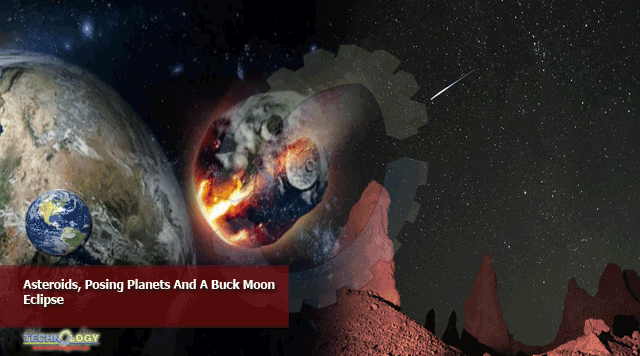Buck moon, What To Watch For In The Night Sky This Week: June 29-July 5, 2020

Something for the weekend? Although today through Friday is ideal for moon-gazing during the afternoon, and for planet-gazing at Jupiter and Saturn rising before midnight, this week the night sky mostly holds back until the weekend. Saturday sees a full Moon quickly followed by a rare (though subtle) “Buck” or “Thunder Moon Eclipse,” with Sunday evening rounding it all nicely with a pretty Saturn-Moon-Jupiter conjunction.
Tuesday, June 30, 2020: ‘Asteroid Day’
Today is Asteroid Day! With any luck there won’t be anything to see hurtling towards us, but it’s a good chance to consider the threat posed to Earth of incoming space rocks. What’s really going to change everything is the Vera Rubin Observatory, which from 2022 will deploy a wide-angle camera to map the night sky in real-time—and identify many thousands of hitherto unfound asteroids.
Saturday, July 4, 2020: Earth at aphelion and a ‘full Buck Moon’
Earth’s orbit of the Sun is not a perfect circle. Today is “Aphelion Day,” the point at which the Earth is furthest from the Sun for the entire year at 152,095,295 kilometers. While at its closest, perihelion on January 5, 2020, it’s 91.4 million miles from the Sun, today at aphelion it’s 94.5 million miles distant. That’s because Earth orbits the Sun in a slight ellipse.
In North America there’s also a full Moon today; that happens at 4:44 UTC on Sunday, so just before midnight in the U.S. However, all it really means is that dusk on Saturday, July 4 will be the best time to watch the full Moon rise. Find out the exact times of moonrise and moonset for your location by using a moon calculator.
North America will also see “tomorrow’s” lunar eclipse, which peaks at 4:29 UTC, which is 00:29 a.m. EDT on July 5 and 9:29 p.m. PDT on July 4.
Sunday, July 5, 2020: ‘Buck Moon Eclipse’ and a Moon-Jupiter-Saturn conjunction
At 4:29 UTC today a penumbral lunar eclipse will peak. At that precise time—which is late on Saturday night from some parts of North America, and just before the full Moon is officially 100%-illuminated from our point of view—about 35% of the full Moon will pass into the Earth’s outer shadow and lose some of its brightness. The exact time of “local max” varies according to where you are in the world, but as lunar eclipses go, it’s pretty technical; don’t expect fireworks.
For some it will be a great chance to stay up very late and watch a beautiful moonset in the west.
Technically on the same day, but at the other side of sunset, the entirety of the world will be able to see the almost full Moon get between bright planets Saturn and Jupiter, which are both itself almost as bright as they will get in 2020. First it will get 1.9° from Jupiter, then 2.5° from Saturn.
This news was originally published at forbes.com